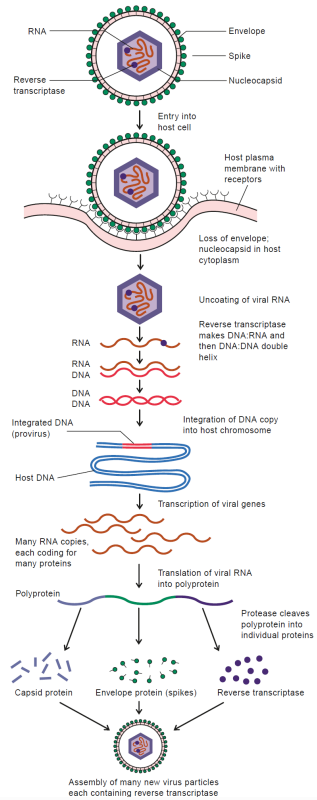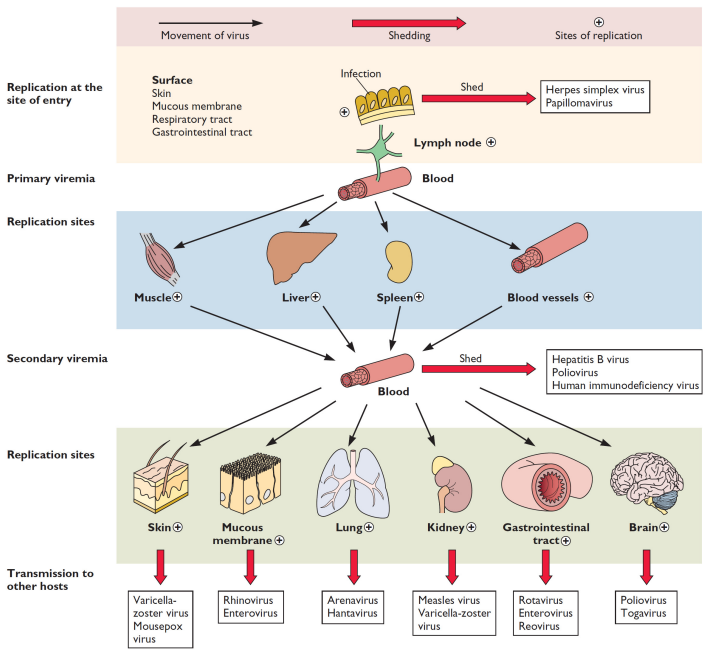6.3 Theme 1 - Viruses & Antiviral Agents
1/11
There's no tags or description
Looks like no tags are added yet.
Name | Mastery | Learn | Test | Matching | Spaced |
|---|
No study sessions yet.
12 Terms
What are the general characteristics of viruses?
Can pass through a 2 µm filter and remain infectious
Totally intracellular - relying exclusively on living cells for replication & persistence
Possess either DNA or RNA as genetic material
Have surface components to facilitate binding to host cells
What are the main morphological features of viruses?
nonenveloped or enveloped, envelope = lipid membrane derived from the host
Virus symmetry can be: Icosahedral, helical, complex
What are the 3 main methods of viral entry into host cells?
Direct penetration – virus binds to the cytoplasmic membrane & releases genetic material into the cell
Membrane fusion – virus binds to receptors, fuses with the membrane, & releases genetic material after capsid breakdown
Endocytosis – virus binds to the cell, is engulfed into a vesicle, & releases genetic material inside the cell
How does a non-enveloped DNA virus replicate?
Attachment – virus binds to host cell
Entry & uncoating – viral DNA released
Transcription – DNA transcribed to mRNA
Replication – mRNA drives DNA & protein synthesis
Assembly – capsid formed
Release – mature virions exit cell
How does an enveloped DNA virus replicate?
Attachment – virus binds to host cell
Entry & uncoating – viral DNA released
Transcription – DNA transcribed to mRNA
Replication – mRNA drives DNA & protein synthesis
Assembly – nucleocapsid forms in the cell
Envelopment & release – virus acquires a lipid envelope from the host’s plasma membrane as it buds out of the cell
How do RNA viruses replicate?
Positive-sense ssRNA (+ssRNA) virus: +ssRNA is directly translated into viral proteins. Viral RNA polymerase transcribes a complementary −ssRNA, which serves as a template to make more +ssRNA for further protein production or packaging
Negative-sense ssRNA (−ssRNA) virus: −ssRNA is transcribed by RNA-dependent RNA polymerase into +ssRNA, which is translated into viral proteins and also copied back into −ssRNA for new virions
Double-stranded RNA (dsRNA) virus: dsRNA is unwound; the + strand is translated into viral proteins, while viral RNA polymerase transcribes the − strand to form complementary RNA for assembly into new virions
How do retroviruses establish latency?
Retrovirus RNA is converted to DNA
Viral DNA integrates into the host chromosome
Provirus may replicate when host cell replicates
Provirus may be transcribed, producing RNA for new retrovirus genomes
Viral protease produces viral proteins
Later activation leads to viral particle production and recurrent infection

How do blood-borne viruses spread in the body?
Enter blood and reach primary replication sites such as muscle, liver, spleen
Cause secondary viremia, sometimes shedding virus
Spread to other replication sites like skin, mucous membranes, lungs, kidneys
Example: chickenpox enters via respiratory tract but causes symptoms (lesions) on skin

How can viral integration lead to cancer?
A virus can insert near a proto-oncogene acting as a promoter. If the proto-oncogene repressor is inactivated (e.g., by a second viral insertion), the oncogene is expressed, potentially leading to cancer.
How does acyclovir (ACV) inhibit viral replication?
Acyclovir is a prodrug and nucleoside analogue that must be phosphorylated to be active
Viral thymidine kinase (HSV-1 TK) adds the first phosphate, which host kinases cannot do
Cellular GMP kinase adds the second phosphate forming acyclovir diphosphate
Cellular NDP kinase adds the third phosphate forming acyclovir triphosphate
Acyclovir triphosphate is incorporated by viral DNA polymerase into viral DNA
Lacking a 3’-hydroxyl group, it causes chain termination and halts viral replication

How does AZT inhibit HIV replication?
AZT targets HIV reverse transcriptase
It is phosphorylated by host cell kinases in three steps to form AZT triphosphate
The 3’ azido group blocks formation of phosphodiester bonds, terminating viral DNA synthesis
Unlike acyclovir, activation occurs in any cell, not just infected cells
Drug can accumulate in non-infected cells
Resistance can develop, so AZT is used in combination therapy (HAART)
How do influenza neuraminidase inhibitors work?
They block neuraminidase activity, preventing cleavage of sialic acid from viral glycoproteins
Without neuraminidase, newly formed influenza virions cannot be released from infected cells
Virus remains trapped in the host cell, preventing further replication and halting disease progression